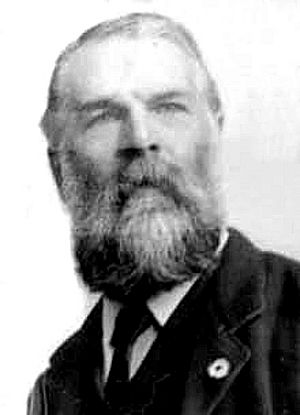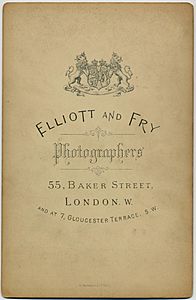- This page was last modified on 17 October 2025, at 10:18. Suggest an edit.
Elliott & Fry facts for kids

The reverse of a carte de visite by Elliott & Fry
|
|
| Formation | 1863 |
|---|---|
| Dissolved | 1962 |
| Purpose | Photography studio |
| Location |
|
|
Key people
|
Joseph John Elliott Clarence Edmund Fry |
Elliott & Fry was a famous photography studio in London. It was started in 1863 by Joseph John Elliott and Clarence Edmund Fry. For about 100 years, they took pictures of many people. They photographed everyday people, but also famous artists, scientists, and politicians. Their main studio was at 55 & 56 Baker Street in London.
A Century of Photography
The Elliott & Fry studio was very important in the Victorian era. They took and published many photographs. Their main business was taking portraits of the public. They also photographed famous people from society, art, science, and politics.
In the 1880s, the company had three studios. They also had four large places to store their photo negatives. Their printing works were in Barnet. The studio at 55 & 56 Baker Street was their home until 1919.
Many photographers worked for Elliott & Fry over the years. These included Francis Henry Hart and Alfred James Philpott. Later, Herbert Lambert and Walter Benington worked there in the 1920s and 1930s. William Flowers also worked for the studio.
During World War II, the studio was bombed. Sadly, most of their early photo negatives were lost. Today, the National Portrait Gallery holds all the negatives that survived. In 1963, the studio was taken over by Bassano & Vandyk.
Joseph John Elliott
Joseph John Elliott was born on October 14, 1835, in Croydon. He passed away on March 30, 1903. In 1864, he married Elizabeth Lucy Fry. She was the sister of his business partner, Clarence Edmund Fry. Joseph and Elizabeth had seven children together.
Joseph Elliott's business partnership with Clarence Fry ended in 1887. Joseph then took over Fry's share of the company. Later, his partnership with his own son, Ernest C. Elliott, also ended in 1892. Ernest Elliott later put together a book of photos. It was called Fifty Leaders of British Sport and was published in 1904.
Clarence Edmund Fry
Clarence Edmund Fry was born in Plymouth in 1840. He passed away in 1897. In 1865, he married Sophia Dunkin Prideaux. Sophia was also a talented artist who colored photographs.
Clarence Edmund Fry was an early supporter of the artist Hubert von Herkomer. In 1873, Herkomer moved to Bushey. He did this to be closer to Fry and to start his own art school.
Clarence was the oldest son of Edmund Fry and Caroline Mary Clarence. His parents were members of the Religious Society of Friends, also known as Quakers. His family was also related to Joseph Storrs Fry. Joseph Storrs Fry was the founder of a famous chocolate factory in Bristol.
Clarence had several siblings. His younger brothers, Walter Henry Fry and Allen Hastings Fry, also became photographers. In 1867, they started their own photography business. It was called W. & A. H. Fry and was located in Brighton.










